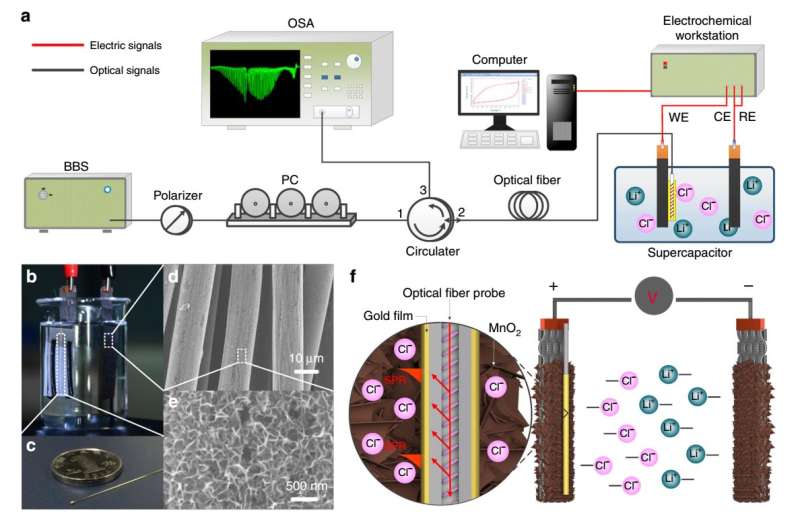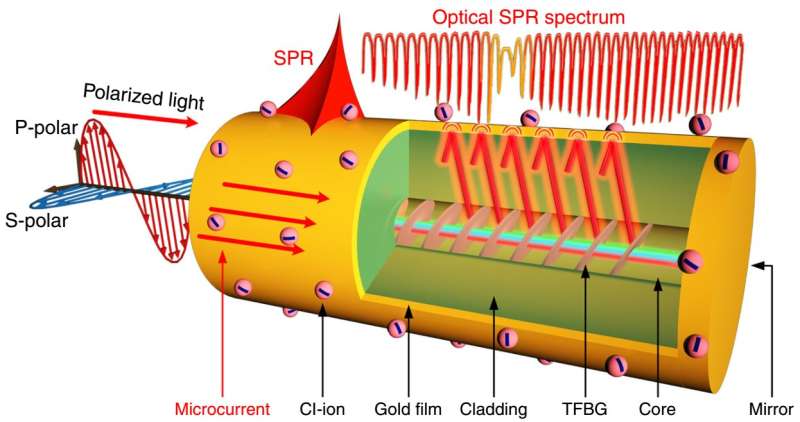Electrochemical surface-plasmon-resonance sensing principle and experimental demonstration with a gold-coated TFBG optical fiber sensor. (a) Experimental setup of a plasmonic fiber-optic sensing system for monitoring the SOC of supercapacitors. (b) Photographs of the configuration for the supercapacitor and (c) gold-coated fiber-optic sensing probe. SEM images of (d) the MnO2 electrode and (e) the corresponding magnified image. (f) Schematic of the measurement of the charge-discharge process of supercapacitors by a plasmonic gold-coated TFBG fiber-optic sensor. Credit: Light: Science & Applicationsvolume 7, Article number: 34 (2018)
A fiber optic sensing system developed by researchers in China and Canada can peer inside supercapacitors and batteries to observe their state of charge.
Renewable energy sources are naturally inconsistent, and thus require new energy storage technologies. Supercapacitors offer rapid charging and long-term storage, but it is important to be able to monitor their working state. To tackle this issue, a team including Tuan Guo and Wenjie Mai at Jinan University adapted an approach based on an optical fiber-based plasmonic sensor. The sensor is embedded inside the capacitor and is able to measure the state of charge of the electrodes and electrolytes in real time, while operating, and over its lifetime. The sensor demonstrates a clear and repeatable high correlation between measurements of the optical transmission of the fiber device and simultaneous supercapacitor's state of charge, offering a unique, low-cost method for real-time monitoring of energy storage devices in operation.
This result has been published in Light: Science & Applications (July 11, 2018), with a manuscript title of "In Situ Plasmonic Optical Fiber Detection of the State of Charge of Supercapacitors for Renewable Energy Storage. "
Electrochemical energy storage devices (such as supercapacitors) are considered to be the next generation of energy storage devices with the highest energy storage efficiency and very promising prospects. They are widely used in clean electric power, electric vehicles, mobile medical, portable electronic devices and other fields. In situ and continuous monitoring is a key method for understanding and evaluation of their performance and operation quality. However, the present methods cannot offer the real-time charge state information when the energy storage devices are in operation. They are required to take the supercapacitors offline (thus interrupting their function) and carry out electrical measurements, and in some cases, opening up the supercapacitors to examine their components by electron microscopy.
To address this fundamental challenge, Prof. Guo and Prof. Mai and their colleague developed optical fiber devices small enough to be inserted near the surface of the capacitor electrodes. Based on telecommunication-grade fibers, they can be left there and monitored remotely at any time and from any distance. Another important aspect of their approach is that in contrast to current techniques that rely on an indirect estimate of the state of charge from current/voltage tests, the optical fiber devices detect the amount of charge accumulated in a sub-micrometer-sized layer on the electrodes and the adjacent electrolyte directly through its impact on the plasmonic properties of a nanometer-scale gold coating applied to the fiber surface.
Electrochemical surface-plasmon-resonance sensing principle and experimental demonstration with a gold-coated TFBG optical fiber sensor. Sketch of the configuration of a plasmonic optical fiber sensor for in situ monitoring of supercapacitors. Credit: Light: Science & Applicationsvolume 7, Article number: 34 (2018)
It demonstrated a clear and repeatable high correlation between measurements of the optical transmission of the fiber device and simultaneous electrical validation measurements. This new technology will have important implications for energy suppliers who rely on renewable energy sources from sun, wind and hydro-electricity for at least part of their power grid requirements. The main implication is that faulty or deteriorating capacitors will be identified before catastrophic failures can occur, and that no interruption of power systems will be required for testing them.
More information: Jiajie Lao et al, In situ plasmonic optical fiber detection of the state of charge of supercapacitors for renewable energy storage, Light: Science & Applications (2018). DOI: 10.1038/s41377-018-0040-y
Journal information: Light: Science & Applications
Provided by Changchun Institute of Optics, Fine Mechanics and Physics
























